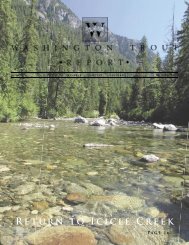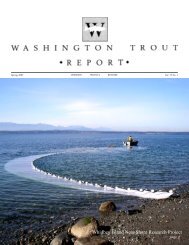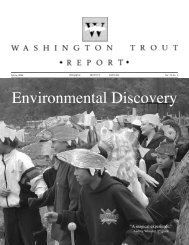Seafood Watch
Pacific Salmon - Wild Fish Conservancy
Pacific Salmon - Wild Fish Conservancy
- No tags were found...
Create successful ePaper yourself
Turn your PDF publications into a flip-book with our unique Google optimized e-Paper software.
<strong>Seafood</strong> <strong>Watch</strong>® Wild Pacific Salmon Report October 8, 2010<br />
and fishing to exterminate or endanger salmon runs. These habitat losses have been particularly<br />
evident in the southern half of salmon’s North American range.<br />
Second, salmon have a highly developed “homing” instinct, generally returning to the specific<br />
lakes and rivers of their birth. This homing instinct is a fundamental component of salmon<br />
biology, and is largely responsible for the formation of discrete populations. While the degree of<br />
homing (and its opposite, “straying”) varies across species and locations, homing creates<br />
reproductive isolation and helps to facilitate localized adaptation (Stewart et al. 2003). The<br />
combination of isolation and adaptation has led to the evolution of numerous Evolutionarily<br />
Significant Units (ESUs), which are treated under Endangered Species Act legislation as separate<br />
species. As a consequence of the diversity of Pacific salmon ESUs, the loss of local populations<br />
increases the chance of losing overall genetic diversity.<br />
Third, Pacific salmon populations are subject to natural fluctuations that can increase their<br />
vulnerability. Salmon populations are strongly influenced by changing atmospheric–oceanic<br />
conditions on a number of different temporal scales. Changes in climate affect oceanic structure<br />
and can generate significant and often sudden differences in salmon marine survival and returns<br />
(Francis and Hare 1994). These include both the subdecadal variability of the El Nino Southern<br />
Oscillation (ENSO) and the longer-scale (50-70 years) climate oscillations that have operated<br />
over the North Pacific for at least the past three centuries.<br />
Over the long-term, sediment cores indicate that sockeye salmon populations have undergone<br />
significant swings during the past two millennia (Finney et al. 2002). For example, populations<br />
were depressed from ~ 100 BC to AD 800, but consistently higher from AD 1200 to 1900.<br />
Similarly, Bristol Bay sockeye salmon have undergone several major shifts over the past three<br />
centuries (Finney et al. 2000). In the medium-term, regime shifts in the subarctic and California<br />
Current ecosystems associated with the Pacific Decadal Oscillation (PDO) have strongly<br />
influenced salmon productivity. A regime shift during the late 1970s (and again in the late<br />
1980s) appears to have reduced oceanic survival of salmon in the Pacific Northwest, while<br />
increasing oceanic survival in Alaska (Hare et al. 1999, Tolimieri and Levin 2004). Hilborn,<br />
Quinn et al. (2003) note that “the productivity of Alaskan sockeye salmon populations appears to<br />
be among the more sensitive biological systems that respond to interdecadal climate shifts and is<br />
strongly coherent with changes in the Pacific Decadal Oscillation.”<br />
In the near-term, smaller scale environmental conditions have significant effects on salmon<br />
population variability. One recent study documents that early marine survival of three species of<br />
salmon from Washington to Alaska is strongly influenced by sea surface temperature (SST)<br />
within a few hundred kilometers of the stock’s natal stream (Mueter et al. 2002). SST is likely a<br />
proxy for changes in ecological interactions in the marine realm. The authors found that survival<br />
of pink, sockeye, and chum salmon was strongly affected by the oceanic processes related to<br />
SST, and that these effects were consistent across species. Interestingly, it appears that water<br />
conditions during the salmon’s first few months at sea have a greater influence on salmonid<br />
survival than larger-scale variability associated with the PDO. Complicating the management<br />
picture, stocks of even the same species may react in a non-uniform manner to changing climatic<br />
conditions (Tolimieri and Levin 2004).<br />
While these fluctuations demonstrate that shifts between productivity regimes occur outside of<br />
the influence of anthropogenic factors, human pressures can add to the natural instability facing<br />
13






